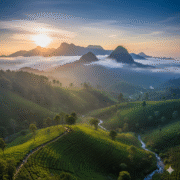
The Life of the Buddha: From Prince Siddhartha to Enlightened Teacher
- November 13, 2025
- eunoialankatours
- 7:04 pm
According to Buddhist tradition, the birth of Siddhartha Gautama—the future Buddha—was no ordinary event. After countless rebirths cultivating virtues known as pāramitā (perfections), the Bodhisattva was invited by the gods to descend from Tusita Heaven. Choosing Queen Māyā of the Sakya clan as his mother, Siddhartha entered her womb in a vision symbolized by a white elephant carrying a lotus flower.
The Divine Invitation and Birth at Lumbini
Ten months later, in 623 BCE, Queen Māyā gave birth to the prince in the beautiful gardens of Lumbini, under a blossoming sala tree. The child immediately took seven steps and declared that this would be his final birth.
Today, Lumbini is a UNESCO World Heritage Site and one of the four great places of Buddhist pilgrimage. Emperor Aśoka’s 3rd-century BCE pillar still marks this sacred birthplace.
Childhood of a Prince and the Great Renunciation
Siddhartha was raised in Kapilavastu, shielded by his father King Suddhodana in three luxurious palaces. Yet, even as a child, Siddhartha showed signs of spiritual depth, once entering a deep meditation under a rose-apple tree—a foreshadowing of his future enlightenment.
At twenty-nine, his life changed forever. Going outside the palace walls, he encountered the Four Sights: old age, sickness, death, and finally an ascetic monk. These sights awakened him to the suffering woven into human existence.
The birth of his only son, Rahula, was described by Siddhartha as a “bond.” That very night, Siddhartha left the palace in what Buddhist texts call the Great Renunciation. He cut off his hair by the river Anoma, wore the monk’s robes, and started his search for the truth.
Struggle and Enlightenment at Bodhgaya
For six years, Siddhartha mastered deep meditation and then subjected himself to extreme asceticism, nearly starving himself to death. Realizing that neither indulgence nor self-mortification led to truth, he discovered the Middle Path—a balanced way of living.
One full moon night in Bodhgaya, Siddhartha sat under the Bodhi Tree and promised not to get up until he reached enlightenment. He overcame the temptations of Māra, the lord of illusion, and attained Sambodhi (Awakening). At dawn, he proclaimed:
“House-builder, you are seen! You shall not build this house again. My mind has attained liberation—this is my last birth.”
The Bodhi Tree at Bodhgaya remains one of the holiest sites in Buddhism today.
The First Sermon at Sarnath
The Buddha didn’t want to teach at first, but Brahma Sahampati convinced him to do so. Traveling to the Deer Park at Sarnath, he preached his first sermon—the Dhammacakkappavattana Sutta (Turning of the Wheel of Dharma)—to his five former companions.
Here, he taught the Four Noble Truths and the Noble Eightfold Path, laying the foundation of Buddhism. With this sermon, the Sangha (community of monks) was born.
Forty-Five Years of Teaching and Parinirvana
For the next 45 years, the Buddha wandered across northern India, teaching kings, merchants, peasants, courtesans, and ascetics alike. His message was simple yet profound:
- All conditioned things are impermanent (anicca).
- All existence involves suffering (dukkha).
- There is no permanent soul (anatta).
- Liberation (Nibbāna) is possible through wisdom, ethics, and meditation.
At the age of 80, the Buddha made his final journey to Kusinara. Lying between twin sala trees, he gave his last words:
“All compounded things are subject to decay. Strive on with diligence.”
He passed into Parinirvana, leaving behind a legacy that would shape the spiritual destiny of millions.
🇱🇰 Sri Lanka and the Legacy of the Buddha
Sri Lanka became a stronghold of Buddhism after Mahinda Thera, son of Emperor Aśoka, introduced the Dhamma in the 3rd century BCE. The island’s sacred sites—Anuradhapura, Polonnaruwa, the Temple of the Tooth in Kandy, and Mihintale—stand as living testaments to the Buddha’s influence.
Magnificent sculptures like the serene Toluvila Buddha and the colossal Gal Vihara statues in Polonnaruwa show how much the island cares about his teachings.
Why This Story Matters to Travelers
For people who visit Sri Lanka and South Asia, following the Buddha’s life is more than just a trip through history; it’s a journey of the heart. Every place, from Lumbini’s peaceful gardens to Bodhgaya’s Bodhi Tree, from Sarnath’s Deer Park to Sri Lanka’s holy Temple of the Tooth, sends out the same message of love, understanding, and peace.
We at Eunoia Lanka Tours invite you to follow in the footsteps of the Enlightened One. Visit the sacred places, old monasteries, and peaceful sculptures that still inspire people from all over the world.


